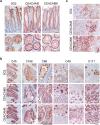Generation of a monoclonal antibody recognizing the CEACAM glycan structure and inhibiting adhesion using cancer tissue-originated spheroid as an antigen
- PMID: 27098764
- PMCID: PMC4838943
- DOI: 10.1038/srep24823
Generation of a monoclonal antibody recognizing the CEACAM glycan structure and inhibiting adhesion using cancer tissue-originated spheroid as an antigen
Erratum in
-
Corrigendum: Generation of a monoclonal antibody recognizing the CEACAM glycan structure and inhibiting adhesion using cancer tissue-originated spheroid as an antigen.Sci Rep. 2016 May 31;6:26575. doi: 10.1038/srep26575. Sci Rep. 2016. PMID: 27241769 Free PMC article. No abstract available.
Abstract
Spheroids cultured directly from tumours can better reflect in vivo tumour characteristics than two-dimensional monolayer culture or three-dimensional culture of established cell lines. In this study, we generated antibodies by directly immunizing mice with primary-cultured living spheroids from human colorectal cancer. We performed phenotypic screening via recognition of the surface of the spheroids and inhibition of their adhesion to extracellular matrices to identify a monoclonal antibody, clone 5G2. The antibody inhibited cell migration in two-dimensional culture and promoted cell detachment. Western blotting and immunohistochemistry detected the 5G2 signal in many colorectal cancer spheroids, as well as patient tumours, but failed to detect in various cell lines examined. We found that 5G2 recognized the Le(a) and Le(c) on N-glycan, and their major carrier proteins were CEACAM5 and CEACAM6. Pre-incubation of the spheroids with 5G2 impaired translocation of integrin β4 from the lateral membrane to the contact interface between the extracellular matrix when embedded in it. As we successfully obtained a functional antibody, which antigen was glycan structures and lost in cell lines, cancer tissue-originated spheroids can be a useful antigen for generating novel anti-cancer antibodies.
Figures







Similar articles
-
Involvement of heregulin/HER3 in the primary culture of human urothelial cancer.J Urol. 2013 Jul;190(1):302-10. doi: 10.1016/j.juro.2012.12.106. Epub 2013 Jan 9. J Urol. 2013. PMID: 23313199
-
Corrigendum: Generation of a monoclonal antibody recognizing the CEACAM glycan structure and inhibiting adhesion using cancer tissue-originated spheroid as an antigen.Sci Rep. 2016 May 31;6:26575. doi: 10.1038/srep26575. Sci Rep. 2016. PMID: 27241769 Free PMC article. No abstract available.
-
Inhibition of adhesion, invasion, and metastasis by antibodies targeting CEACAM6 (NCA-90) and CEACAM5 (Carcinoembryonic Antigen).Cancer Res. 2005 Oct 1;65(19):8809-17. doi: 10.1158/0008-5472.CAN-05-0420. Cancer Res. 2005. PMID: 16204051
-
Promotion of malignant phenotype after disruption of the three-dimensional structure of cultured spheroids from colorectal cancer.Oncotarget. 2018 Mar 23;9(22):15968-15983. doi: 10.18632/oncotarget.24641. eCollection 2018 Mar 23. Oncotarget. 2018. PMID: 29662620 Free PMC article.
-
Identification of anti-tumour biologics using primary tumour models, 3-D phenotypic screening and image-based multi-parametric profiling.Mol Cancer. 2015 Jul 31;14:147. doi: 10.1186/s12943-015-0415-0. Mol Cancer. 2015. PMID: 26227951 Free PMC article.
Cited by
-
Identification of Targets to Redirect CAR T Cells in Glioblastoma and Colorectal Cancer: An Arduous Venture.Front Immunol. 2020 Sep 30;11:565631. doi: 10.3389/fimmu.2020.565631. eCollection 2020. Front Immunol. 2020. PMID: 33101285 Free PMC article. Review.
-
Study of glycosylation of prostate-specific antigen secreted by cancer tissue-originated spheroids reveals new candidates for prostate cancer detection.Sci Rep. 2020 Feb 17;10(1):2708. doi: 10.1038/s41598-020-59622-y. Sci Rep. 2020. PMID: 32066783 Free PMC article.
-
Delivery of a BET protein degrader via a CEACAM6-targeted antibody-drug conjugate inhibits tumour growth in pancreatic cancer models.Nat Commun. 2024 Mar 11;15(1):2192. doi: 10.1038/s41467-024-46167-1. Nat Commun. 2024. PMID: 38467634 Free PMC article.
-
Carcinoembryonic antigen-related cell adhesion molecule 6 (CEACAM6) promotes EGF receptor signaling of oral squamous cell carcinoma metastasis via the complex N-glycosylation.Oncogene. 2018 Jan 4;37(1):116-127. doi: 10.1038/onc.2017.303. Epub 2017 Sep 11. Oncogene. 2018. PMID: 28892050
-
Evaluation of the Anti-Tumor Activity of the Humanized Monoclonal Antibody NEO-201 in Preclinical Models of Ovarian Cancer.Front Oncol. 2020 Jun 19;10:805. doi: 10.3389/fonc.2020.00805. eCollection 2020. Front Oncol. 2020. PMID: 32637350 Free PMC article.
References
-
- Weigelt B., Lo A. T., Park C. C., Gray J. W. & Bissell M. J. HER2 signaling pathway activation and response of breast cancer cells to HER2-targeting agents is dependent strongly on the 3D microenvironment. Breast Cancer Res. Treat. 122, 35–43, doi: 10.1007/s10549-009-0502-2 (2010). - DOI - PMC - PubMed
Publication types
LinkOut - more resources
Full Text Sources
Other Literature Sources
Molecular Biology Databases
Research Materials

